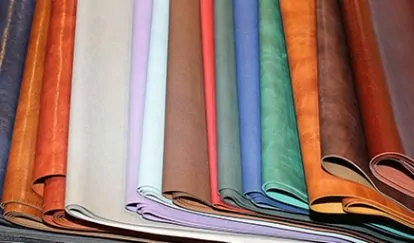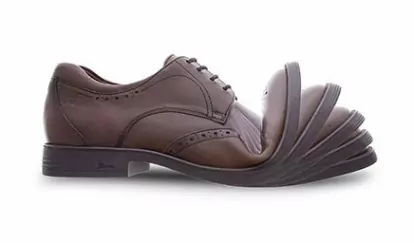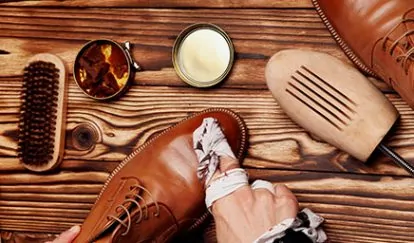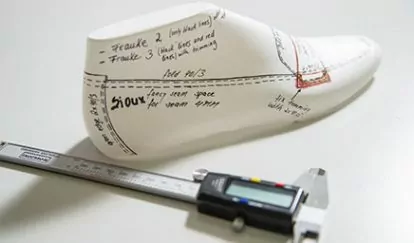SHOE LEATHER
The most important part of the shoe – high-quality shoe leather
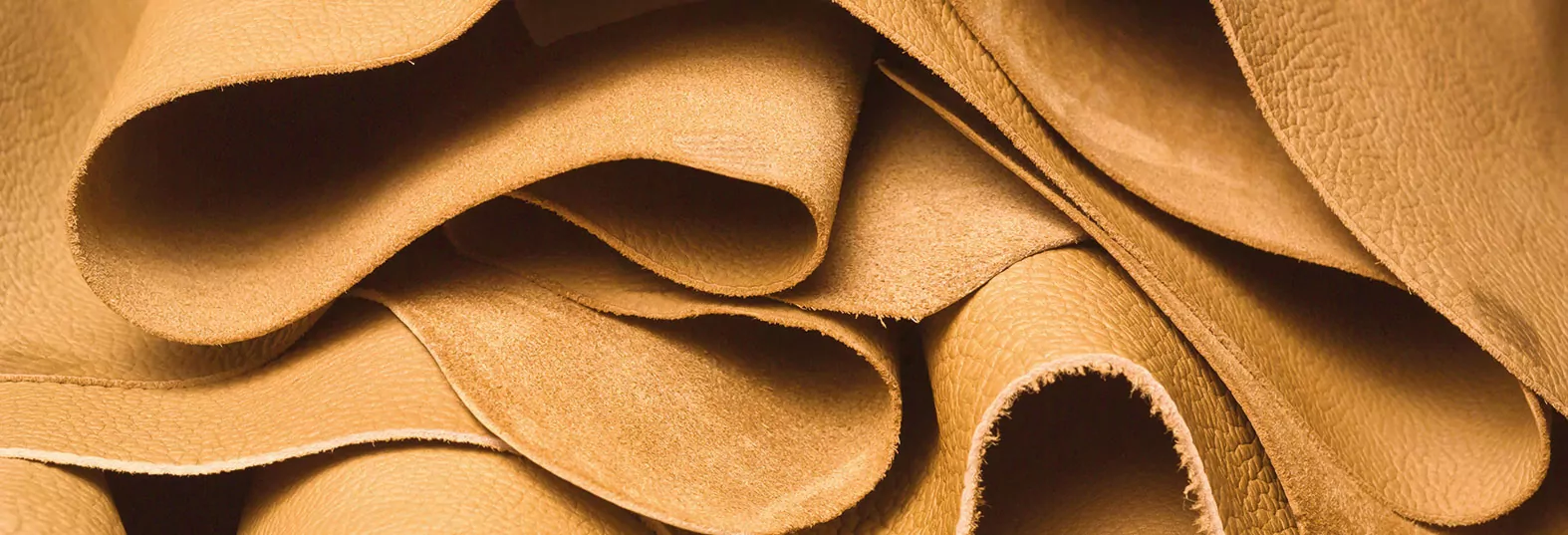
Choosing the leather is very easy when it comes to Sioux shoes: we only settle for the best.
Genuine leather is a fascinating natural product. You are able to discover traces of a life when looking at layers of leather. The animal’s origin, farming methods – animals who were able to graze freely have fewer scars – and even the food that the animal used to eat over the course of its life plays a huge role. You can also estimate how old an animal was by examining the leather. Every piece of leather is therefore ultimately an extraordinary, unique creation. And beautiful leather can reveal its unique character in our high-quality shoes.
What’s special about leather?
Leather has a number of very special, natural properties: It is breathable, heat-insulating, stretchy, tearproof and abrasion-resistant and acts a barrier against moisture evaporation. It is also robust, making the shoe more stable and functional. From a stylistic point of view, it gives the shoe its very unique look. In order to achieve this, the raw animal hides are carefully selected, and only the best are prepared for the tanning process. What’s more: The leather gets its typical smell and exquisite look during the last step of processing – the preparation.
The best feature of leather and what makes it so great for shoe-making is its ability to naturally absorb a relatively large amount of moisture and release it as well. No other comparable material is capable of this. When the shoe is worn, it absorbs moisture produced by the feet and thus ensures a pleasant shoe climate. When it is taken off again, the leather regenerates and becomes dry and returns to its original state after 12 to 24 hours. We would particularly recommend using a wooden shoe tree.
Leather is a very traditional material to use. Just as the classic shoe models have hardly changed in terms of their construction and style since the 19th century, only leather of the finest quality has been used to produce high-quality shoes for longer than can be remembered. It’s the same now as it was back then: meticulous care needs to be taken in order to maintain its appearance and make it durable in the long run. The person wearing the shoe is rewarded with a perfect fit that keeps the foot nice and healthy too.
How do leathers differ?
When it comes to footwear, a distinction is made between the leather used for the top, lining and bottom, as well as the leather of the insole. These types of leather differ as a result of the different demands placed on them. Uppers need to be supple, breathable and robust at the same time. Due to the fact that it is in direct contact with the wearer’s foot, lining leather must be especially breathable, soft and cosy, but at the same time abrasion-resistant and colour-fast. The leather used for the outer sole, on the other hand, needs to resist absorbing any water and, most importantly, be abrasion-resistant. These different requirements are ensured by the correct selection of the raw animal hide (which kind of leather and which body part of the animal) as well using the correct processing methods to turn the raw hide into ready-to-use leather.
It is with this in mind that, at Sioux, we use only the best, tested quality of leather. This is primarily the upper layer of leather, i.e. the grain side or split leather, which is found directly underneath the grain side. We make the parts that become particularly worn down when wearing from the best part of the back. The most dense and even fibre structure can be found here. A pair of Sioux shoes are always cut from the same hide so that they look the same.
How is the correct leather selected?
Each leather hide is thoroughly inspected by Sioux’s leather buyers: perfect workmanship and a flawless grain pattern is of the utmost importance to them. The more natural the leather is, the more beautiful it is – and the more likely that it will be brought to life once more on the feet of a Sioux wearer.
The special quality of the leather is reflected in the tanning process. Sioux selects leather exclusively from tanneries that we know personally, since the leather can be followed from the source, right through to the end product at these tanneries. The high-quality leathers are mainly dyed in barrels, hence the dye penetrates the entire leather. This is guaranteed by regular checks conducted by Sioux staff in the Quality Assurance department and by independent testing institutes. Sioux has developed comprehensive compliance guidelines; each supplier is audited and approved as part of a complex process. There are only a few selected suppliers with whom we have built up a long-term business relationship. Indeed, quality is based on this level of trust. Compliance with all relevant thresholds is verified by German testing laboratories.
OUR PRODUCT RECOMMENDATIONS FOR YOU
Finishing leather
Leather only becomes the material we appreciate so much in shoes during the final step. The process carried out in the finishing shop is responsible for this change, as it receives its elegant appearance and typical smell.
Leather production
Leather has been manufactured since the early history of humankind, as this high-quality and durable raw material can be used to make shoes. Native Americans developed the first-known type of shoe – the moccasin. Tanned buffalo skin was used to make these shoes. The buffalo was hunted primarily as a source of meat, but the hides, tendons and bones were processed and used for many different purposes.
Types of leather
At Sioux we place value on offering premium quality and comfort as well as a modern look. As a result of the various types of leather, tanning processes and colours, Sioux incorporates over 200 different varieties of leather into its collections to ensure that the highest standards are met. From non-slip, smooth leather and colourful suede and nubuck leathers, to reptile, metallic and glossy looks, everything has the same inimitable Sioux quality.
Shoe construction techniques
Why are there so many different shoe models? The construction technique used by Sioux depends on what the shoe will be worn for and what the wearer requires from it. Because, ultimately, the shoe must have a perfect fit.
Things you should consider when buying shoes
The following 10 tips will give you a practical guide and help you with your next shoe purchase. Besides the right shoe size and width, an optimal fit, skilful workmanship and the use of high-quality materials for the upper, lining and outsole are also important factors when it comes to quality and selection. We want you to stay feeling comfortable in your shoes for as long as possible.
Crepe sole
Learn more about what is undoubtedly the most natural form of comfort - everything about this Sioux speciality can be found here.
Labelling of materials
A question frequently asked by our customers is: “How can I be sure that the material used is really genuine leather?"
The history of footwear
More than 40,000 years ago, people developed a need to protect their feet against adverse external conditions. It took several centuries, however, until the fashionable and comfortable footwear that we are familiar with today became available.
Sioux hallgus protect
The combination of high-quality leather and our innovative Sioux-Tex climate membrane will give your feet that “feel-good” feeling: whilst moisture and vapour are quickly wicked away from the shoes, water from the outside has no chance of getting in, meaning your feet are always warm and dry.
Sioux natural move system
The combination of high-quality leather and our innovative Sioux-Tex climate membrane will give your feet that “feel-good” feeling: whilst moisture and vapour are quickly wicked away from the shoes, water from the outside has no chance of getting in, meaning your feet are always warm and dry.
SiouxTex
The combination of high-quality leather and our innovative Sioux-Tex climate membrane will give your feet that “feel-good” feeling: whilst moisture and vapour are quickly wicked away from the shoes, water from the outside has no chance of getting in, meaning your feet are always warm and dry.
Shoe lining
Consumers often only pay attention to whether they like a shoe and whether it fits well. What is inside the shoe should also be a decisive factor: the shoe lining is often underestimated when buying shoes, despite being a key factor when it comes to comfort and health. Below we will explain the various types of shoe lining, their uses and the importance of shoe lining when it comes to your well-being.
Shoe soles
Whether they are a lightweight and flexible, feature unique air-cushioning or have a timeless and elegant leather sole: it's the perfect join of the shoe upper and sole which is the finishing touch to each and every shoe.
Shoe size and fit
As the foot performs a rolling motion when walking, it bears your weight in various areas and thus changes shape in doing so. The hallmark of a perfect-fitting shoe is that the toes and the foot itself have enough space within the shoe throughout this rolling motion and that the heel experiences sufficient grip. When a shoe fits, the heel does not slip out of the back of the shoe, and the shoe sits so perfectly in the midfoot area that the foot is supported – and is unable to slip forwards – hence the shoe pinching.
Shoe leather
Choosing the leather is very easy when it comes to Sioux shoes: we only settle for the best.
Shoemaking
There are lots of steps involved in making a shoe. From developing the model in the first instance, to the stamping, sewing and putting the finishing touches to the shoe at the very end.
Grashopper
In the 1960s, the natural form moccasin was a revolution. Today, the cult shoe is more topical than ever as a pioneer in modern casual wear.
 DE
DE EN
EN FR
FR NL
NL



